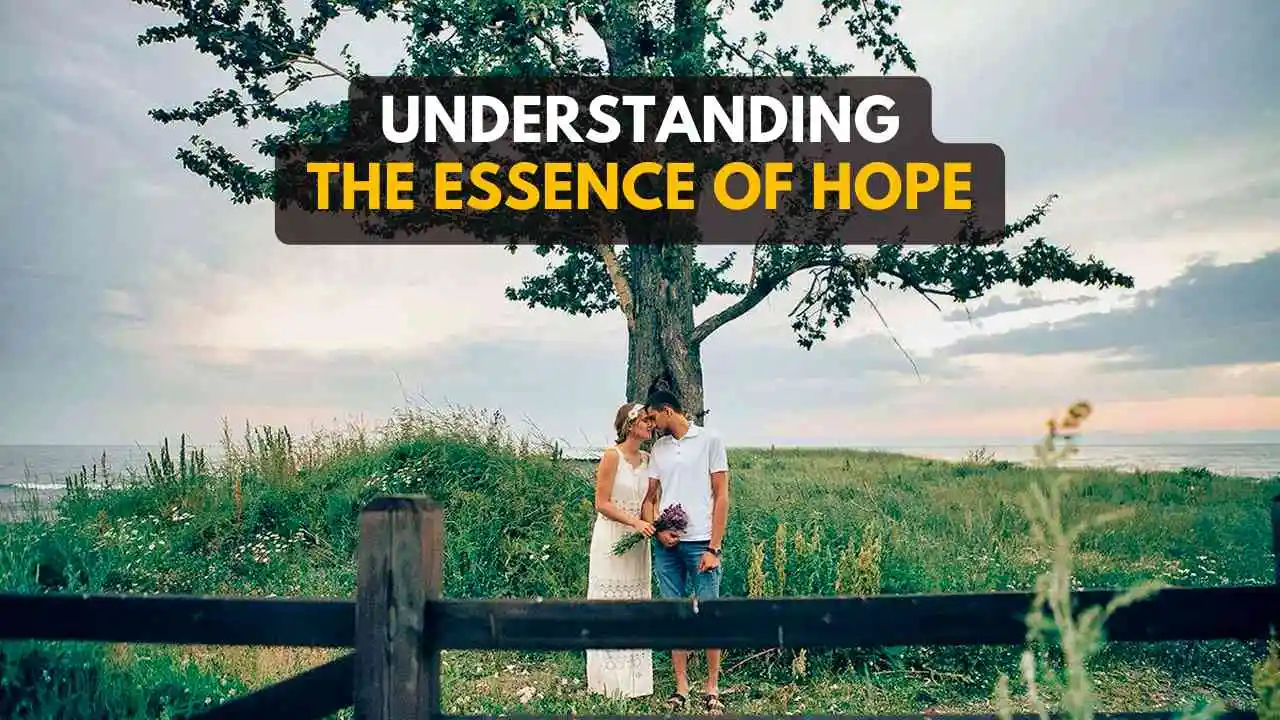Today's Saturday • 12 mins read
Hope is different from optimism:
- Hope is a sense of positive expectation, as well as a desire to work toward that expectation.
- Optimism is having a good feeling about the future without doing anything to make it happen.
More often, hope is a fleeting feeling. If we don’t act on it while hopeful, it may disappear. Still, hope can sometimes come as an overpowering emotion or a determined attitude.
Positive psychology defines hope as:
“A state of mind that reflects accepting one’s situation without judgment, optimism about one’s future, and the willpower to change things for the better to the best of one’s ability.”
Hope means “an expectation of good, pleasure, or achievement” and “a firm belief in something that is not evident.”
How To Make Hope Work
Hope combines clear goals, perceived pathways to reach them, and the belief you can mobilize the will (agency) to follow those pathways.
6 Core Steps To Make Hope Work
- Set clear, achievable goals. Break big aims into specific short-term targets (weeks or days). Make your goals SMART: specific, meaningful, attainable, realistic, and time-bound.
- Build multiple pathways to those goals. For each goal, list at least two different routes to progress. If one route stalls, switch to an alternative rather than stopping.
- Strengthen your agency (willpower + motivation). Track small wins daily to reinforce the belief you can act. Use “if–then” plans: “If X happens, then I will do Y.” Pair actions with identity statements: “I’m someone who…,” not just “I want…” Identity-based habits can speed up your success routine.
- Manage setbacks productively. Treat setbacks as information about strategy, not as proof you lack ability. Reframe: Ask yourself, “What do I need to change?” instead of “Why did I fail?”
- Gather psychological resources. Build your energy: Optimize your sleep, movement, and nutrition. Strengthen social support: Share goals with at least one supportive person. Practice emotion regulation (brief breathing, labeling feelings) so discouragement doesn’t derail effort.
- Practice hope habits daily. Morning: Review one short goal and the next small step. Evening: Note one progress point and one lesson. Weekly: create or revise pathways; celebrate progress.

Simple exercises (5–15 minutes)
- Goal-splitting: Take a long-term goal and write three concrete next-week actions.
- Alternate-path listing: List three backup methods for one action you struggle with.
- Agency log: Each evening, write one thing you did that moved you forward and why it mattered.
Signs hope is working
- You notice small, consistent progress.
- You try multiple approaches instead of giving up.
- Setbacks prompt strategy changes, not identity threats.
1. Why is hope so important?
Hope drives us to act, especially in times of uncertainty. It allows us to endure adversity (grit), believe in a better future (optimism), and keep going until we achieve happiness and peace.
Here’s why hope is important:
- Meaning and Purpose: Hope encourages us to envision a better future for ourselves and others by fostering a sense of meaning and purpose in our lives. It inspires us to strive for positive change and contribute to a more flourishing world.
- Motivation and Perseverance: Hope provides the impetus to pursue goals, even when we’re facing obstacles, and encourages us to persist in the face of setbacks. It acts as a driving force, reminding us that their efforts are worthwhile and that a better outcome is possible.
- Resilience and Coping: Hope is a cornerstone of emotional resilience. It enables us to bounce back from adversity, disappointment, or loss. It nurtures a belief that difficult situations are temporary and that brighter days lie ahead.
- Positive Outlook and Well-being: Hope (especially the agency of hope) has been linked to positive emotions (Chang & Chang, 2018). That is, hopeful people are happier and have better overall well-being. Hope has also been linked to a reduced risk of depression and anxiety, and a more optimistic and purposeful outlook on life.
- Mental and Physical Health: Research suggests higher levels of hope are associated with better physical and mental health outcomes. People with high hope have fewer chronic illnesses and a reduced risk of all-cause mortality.
2. What gives a person hope?
Ultimately, hope is a personal feeling. So, what gives a person hope to endure difficult times and to stay the course?
Personal Factors:
- Setting and achieving goals: Having clear goals and making progress towards them can boost optimism and create a sense of agency, which are key components of hope.
- Finding meaning and purpose: Connecting with something larger than oneself, whether through spirituality, activism, or personal passions, can provide a sense of meaning and direction that fuels hope.
- Practicing gratitude: Focusing on the positive aspects of one’s life, even during difficult times, can foster a sense of appreciation and optimism, which are closely linked to hope.
- Developing self-compassion: Being kind to oneself, especially during setbacks, can help maintain a positive outlook and belief in one’s ability to overcome challenges.
- Celebrating small wins: Acknowledging and appreciating progress, no matter how small, can create a sense of momentum and reinforce the belief that positive change is possible.
External Factors:
- Strong social connections: Having supportive relationships with family, friends, and community members can provide a sense of belonging and encouragement, which are crucial for fostering hope.
- Witnessing acts of kindness and resilience: Observing acts of compassion and the ability of others to overcome adversity can inspire hope and a belief in the inherent goodness of humanity.
- Spending time in nature: Connecting with the natural world can have a calming and uplifting effect, promoting a sense of peace and well-being that can foster hope.
- Finding inspiration in others: Reading about or interacting with individuals who have overcome significant challenges can provide motivation and a sense of possibility.
- Engaging in activities that bring joy and fulfillment: Participating in hobbies, pursuing creative endeavors, or engaging in activities that align with one’s values can boost mood and create a sense of hope.
“Hope is what keeps us alive when we have given up,” — Brian Tracy.
3. How to be hopeful in life?
Building hopefulness involves cultivating a positive mindset, taking goal-directed actions, strengthening resilience and social support, and seeking inspiration and hope from others.
Here’s how to build hopefulness in ourselves:
Cultivate a Positive Mindset
- Challenge Negative Thoughts. Actively challenge your negative thought patterns and replace them with more positive and realistic perspectives.
- Practice Gratitude. Focus on the positive aspects of your life. Noticing even little positive things can shift your perspective and boost your mood.
- Remember Past Successes. Reflect on your past achievements. It can boost your ability to challenge and overcome challenges.
- Practice Mindfulness. Being present in the moment can help reduce anxiety and worry about the future, fostering a sense of calm and hope.
- Visualize Success. Imagine yourself achieving your goals and experiencing positive outcomes, which can motivate you to take action.
Take Action and Set Goals
- Set Achievable Goals: Break down larger goals into smaller, manageable steps to experience a sense of progress and accomplishment.
- Create a Hope Map: Identify your goals, potential obstacles, and pathways to overcome them, which can help you feel more in control and confident.
- Engage in Meaningful Activities: Pursue hobbies, interests, or activities that bring you joy and a sense of purpose.
- Engage in Acts of Kindness: Helping others can boost your mood and reinforce your sense of connection and purpose.
Build Resilience and Support
- Build a Support Network: Surround yourself with people who offer encouragement, support, and positive energy.
- Practice Self-Compassion: Be kind and understanding towards yourself, especially during challenging times.
- Seek Professional Help: If you’re struggling with persistent feelings of hopelessness, consider seeking guidance from a therapist or counselor.
- Focus on Strengths: Identify and utilize your personal strengths to navigate challenges and build confidence.
- Learn from Setbacks: View setbacks as learning opportunities and develop coping mechanisms to bounce back stronger.
Seek Inspiration and Hope
- Find Inspiration in Others: Seek out individuals who embody hope and resilience, and learn from their experiences.
- Read Inspiring Stories: Explore biographies, memoirs, or articles that highlight resilience and hope in the face of adversity.
- Connect with Nature: Spending time in nature can be calming and restorative, fostering a sense of hope and connection to something larger than yourself.

4. How can I bring hope to others?
We can help others be hopeful by being an icon of hope ourselves. We can give others hope by actively listening, validating their feelings, and reminding them of their strengths and past successes.
Here’s how to bring hope to others:
Active Listening and Validation
- Listen without judgment: Create a safe space for them to express their feelings without interruption or criticism.
- Validate their emotions: Acknowledge that their feelings are valid and understandable given their circumstances.
- Empathize: Try to understand their perspective and show that you care about their experience.
Focus on Strengths and Possibilities
- Remind them of past successes: Help them recall instances where they overcame challenges or achieved something they were proud of.
- Highlight their positive qualities: Point out specific strengths, skills, or traits that you admire about them.
- Encourage positive thinking: Help them shift their focus from negative thoughts to possibilities and potential solutions.
Offer Practical Support and Encouragement
- Set small, achievable goals: Help them break down large tasks into smaller, manageable steps.
- Offer practical help: Suggest specific ways you can assist them, such as running errands, providing childcare, or offering a listening ear.
- Be a consistent presence: Let them know you are there for them and available to offer support.
- Share inspiring stories: Use narratives of resilience and hope to illustrate that positive outcomes are possible, even in difficult situations.
Cultivate a Positive Mindset
- Be a source of positivity: Your own optimistic outlook can be contagious and offer a sense of hope.
- Encourage self-care: Suggest activities that can help them relax, recharge, and manage stress, such as exercise, spending time in nature, or pursuing hobbies.
- Remind them of their worth: Let them know they are valued and loved for who they are.
Avoid False Hope or Dismissing Their Feelings
- Be genuine and sincere: Avoid platitudes or empty reassurances that don’t address their specific concerns.
- Acknowledge the difficulty of their situation: Don’t minimize their pain or tell them to “just get over it”.
5. Can you live without hope?
A hopeless person may have little hope for future progress or success, or a purpose to engage with life events proactively, but they can live.
Humans are remarkably resilient and can find meaning and purpose in other aspects of life, even when faced with difficult circumstances or a lack of traditional hope.
Living Without Hope:
- Possible, but Difficult: Some individuals may find ways to navigate life without traditional hope, perhaps by focusing on the present moment, finding meaning in simple things, or accepting the inevitability of suffering.
- Potential Challenges: A lack of hope can lead to feelings of despair, apathy, and a sense of meaninglessness, which can negatively impact mental and physical health.
- Finding Alternatives: In the absence of hope, individuals may find other sources of motivation, such as a strong will to survive, a commitment to personal values, or a desire to support others.
However, hope is considered a key motivator and a source of resilience, and its absence can be damaging to mental and emotional well-being. Hopelessness is common in people with depression, anxiety, bipolar disorder, eating disorders, substance abuse, suicidal ideation, and post-traumatic stress disorder (PTSD).
6. What is the power of hope?
Hope is a powerful capability of the human mind. It gives us strength, courage, and resilience. Hope gives us the power to push through difficult times. It gives us the motivation to make changes in our lives.
Hope Is A Driving Force In Human Life:
- Motivation and Resilience: Hope motivates us to persevere through challenges and setbacks, offering a belief that things can improve or that a desired outcome is possible.
- Purpose and Meaning: Hope can be linked to a sense of purpose in life, whether it’s personal goals, relationships, or a belief in a higher power.
- Mental Well-being: Hope is often associated with positive emotions, reduced anxiety and depression, and a greater sense of control.
7. Is there a negative side to hope?
Hope can be a double-edged sword, especially for people with anxiety and panic disorders:
- On one hand, it can protect against anxiety by keeping people positively motivated to act.
- On the other hand, it can lead people to overestimate their chances of success, which can worsen their anxiety.
For a person with fixed views, having too much hope can backfire. They can have unrealistically high expectations and face utter disappointment and inadequacy when those expectations are not met.
At this point, if we refuse to accept the negative results and continue to hope in the same way without modifying our techniques, we risk jeopardizing our future chances.
As a psychological concept, hope means being “willing to persevere in the face of difficulty” and “a determination to succeed.”
Final Words
When we are hopeful, it helps us play the game of life with more confidence, resources, and energy.
So, when we feel hopeless and discouraged, we must strive to become more hopeful. However tough it is, we can build a positive attitude over time with tiny hopeful steps each day.
Some easy ways to fill up our reservoirs of hope are getting proper sleep, exercising, being around positive people, and setting goals.
√ Also Read: How To Set Goals: 3 Techniques (And 2 Secrets That Work).
